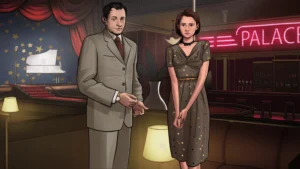
The Silver Lining
Play The Silver Lining
The Silver Lining review
Exploring the immersive experience and features of The Silver Lining game
The Silver Lining game stands out in its genre by offering a distinctive blend of interactive storytelling and immersive gameplay. This article dives into what makes The Silver Lining captivating for its audience, highlighting its unique narrative style, character development, and gameplay mechanics. Whether you’re curious about the game’s features or looking for tips to enhance your experience, this guide covers everything you need to know about The Silver Lining.
Understanding The Silver Lining Game: Storyline and Gameplay
Ever stumbled upon a game that feels less like a pastime and more like stepping into another world? 😲 That was my exact experience with The Silver Lining. From the moment I booted it up, I wasn’t just holding a controller; I was holding a key to a deeply personal and captivating adventure. If you’re curious about what makes this title so special, you’ve come to the right place. We’re going to peel back the layers on its heart and soul: The Silver Lining game storyline and the brilliant The Silver Lining gameplay features that bring it all to life.
### What is The Silver Lining game about?
At its core, The Silver Lining is a love letter to classic point-and-click adventures, but with a modern, emotional depth that truly sets it apart. 🎭 The narrative centers on Alexander, a man grappling with a profound personal tragedy. After a devastating loss, he retreats into a comatose-like state, and the entire game takes place within the intricate, dreamlike landscape of his own subconscious.
The goal? To guide Alexander as he pieces together fragmented memories, confronts symbolic manifestations of his grief and guilt, and ultimately fights his way back to consciousness and hope. This immersive game narrative is the true star of the show. It’s a poignant exploration of loss, redemption, and the human spirit’s resilience. You don’t just watch Alexander’s journey; you feel every step of it alongside him.
A huge part of what makes The Silver Lining characters so compelling is their symbolic nature. You won’t just meet random NPCs; you’ll interact with personifications of Alexander’s emotions—like Denial, Anger, and Depression. 🎭 Talking to them isn’t about fetching quests; it’s about unraveling the psychological puzzle of a broken man. I remember one particular conversation with “Oblivion,” a character representing Alexander’s desire to forget his pain. The dialogue was so raw and well-written that it completely halted my progress—I just had to sit and absorb the weight of it all.
### Key gameplay mechanics and features
So, how do you navigate this world of dreams and memories? The gameplay mechanics in The Silver Lining are a masterclass in how form can follow function. This isn’t a game about quick reflexes; it’s a game about observation, intuition, and thought.
As a modern interactive storytelling game, it utilizes a traditional point-and-click interface that feels perfectly suited to its pace. You’ll explore beautifully painted environments, examine objects closely, and combine items in your inventory to solve puzzles. But the magic is in the details. The cursor changes to indicate when you can look, talk, or interact with something, making the exploration intuitive and rewarding.
One of the most standout The Silver Lining gameplay features is its dialogue system. Conversations are not on rails. You often have multiple dialogue choices that can change the flow of a conversation and even affect how characters perceive you later on. This makes every interaction feel meaningful and gives you a genuine sense of agency within the fixed narrative.
Here’s a quick breakdown of how the key features work together to create the experience:
| Gameplay Feature | Narrative Impact | Player Experience |
|---|---|---|
| Point-and-Click Exploration | Allows for slow, deliberate discovery of the dream world and hidden memory clues. | Encourages patience and attention to environmental storytelling. |
| Puzzle Solving (Inventory & Environmental) | Puzzles are metaphors for working through psychological blocks (e.g., unlocking a memory). | Provides a deep sense of accomplishment that is tied directly to story progression. |
| Branching Dialogue Trees | Allows players to explore different facets of Alexander’s personality and relationships. | Creates a personalized connection to the story and **The Silver Lining characters**. |
| Symbolic Character Interaction | Personified emotions drive the plot and reveal Alexander’s internal state. | Turns every conversation into a compelling narrative event, not just exposition. |
This seamless fusion is what makes it such a memorable interactive storytelling game. You’re not just solving puzzles to advance; you’re solving them to understand.
### How the storyline enhances player engagement
The brilliance of The Silver Lining game storyline is that it is the engine of engagement. You aren’t playing to see what happens next; you’re playing to understand what happened. The narrative constantly dangles mysteries—What was the tragedy? Who is the mysterious woman in his memories? Why is this owl following him? 🦉—that are far more powerful motivators than any simple “level up” reward.
Because the puzzles and gameplay mechanics in The Silver Lining are so deeply woven into the narrative, every solved puzzle feels like a personal breakthrough. I recall spending what felt like an hour stuck in the “Forest of Denial,” trying to figure out how to get past a river of tears. The solution wasn’t just about using the right item; it was about realizing what that item symbolized in Alexander’s life. When it finally clicked, the emotional payoff was immense. I didn’t just open a path; I helped Alexander accept a painful truth.
This is the secret sauce. The game makes you an active participant in the healing process. You are not a bystander. Your curiosity drives the investigation into Alexander’s past, and your perseverance mirrors his own struggle to overcome despair. This connection is what transforms it from a good game into an unforgettable experience.
For anyone wondering how to play The Silver Lining for maximum impact, my advice is simple: lean into the story. 👂
Tip: Don’t rush. Talk to every character multiple times, exhaust all dialogue options. The key to progressing often lies in understanding the emotional subtext, not just finding the right pixel to click.
Read every journal entry and examine every object. The environment is dripping with lore and clues that enrich the immersive game narrative. Let yourself be slow, be thoughtful, and be present in Alexander’s world. By engaging with the story on its own terms, you’ll unlock the deepest and most rewarding layer of this incredible interactive storytelling game.
The Silver Lining game offers a compelling mix of rich storytelling and engaging gameplay that captivates its audience. Its unique narrative approach combined with interactive mechanics creates a memorable experience for players. Whether you’re new or returning, understanding the game’s core elements can greatly enhance your enjoyment. Dive in, explore the story, and discover the many layers that make The Silver Lining a standout title.









